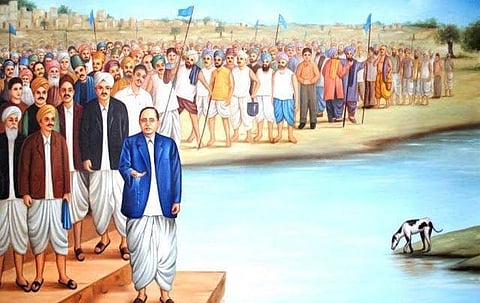
On 20th March 1927, almost three years before the famous Namak Satyagraha, residents of Mahad in Maharashtra took a satyagraha which pertained to a basic human right — drinking water. The water of Chowdar tank in Mahad was off-limits to the untouchables, while at the same time, this place was accessible to animals.
Chowdar Tank is situated in Mahad, which has been a business centre since a long time as it served as a port once. The untouchables often visited the area for shopping or as part of their duty as village servants to dispatch the correspondence sent by village officials or to pay the government revenue collected by village officials.
The Chowdar tank was the only public tank in Mahad, but the untouchables were forbidden from drinking water from the tank. So the only source of water for the untouchables was the well in the Untouchables quarter in the town of Mahad, which was far away (as is the case with the settlements of untouchables) from the centre of the town. So the untouchables found it a struggle to quench their thirst.
It was in 1923 that the Legislative Council of Bombay passed a resolution that the untouchable classes be allowed to use all public watering places built and maintained out of public funds.
In 1924, Mahad Municipality also passed a resolution on 5th January 1924 to the effect that the Municipality had no objection to allowing the untouchables to use the tank.
Despite the resolution of Mahad Municipality and the Bombay legislative Council, the tank was still inaccessible to the untouchables. So on 18th and 20th March, a conference was held at Mahad, where about 2,500 untouchables had assembled. Ambedkar exhorted them to exercise their right bestowed upon them. The crowd led by Ambedkar marched in a procession. This bravado of the untouchables had infuriated the upper-caste Hindus of the area.
Dr. Ambedkar's speeches and writings in volume 5 mention a quote where he describes a scene where the Hindu inhabitants of a town witnessed the procession of Untouchables drinking water from the Chawdar tank. The Hindus were taken aback and stunned by this scene, which they had never seen before. However, soon after, the Hindus realized what had happened and went into a frenzy, committing all sorts of atrocities upon the Untouchables who had dared to pollute the water.
The Bombay Chronicle reported an incident of assault on a crowd belonging to the depressed class. The procession was peaceful and passed quietly for about two hours. However, some wicked leaders of the town spread false rumors that the depressed classes were planning to enter the Vireshwar temple. As a result, a large crowd of riffraff armed with bamboo sticks gathered and became aggressive. The whole town turned into a surging mass of rowdies who appeared to be out for the blood of the depressed classes.
The Hindus could not tolerate the untouchables’ basic exercise of their right. They considered the water to have been made impure by the untouchables by drinking it. So they drew 108 earthen pots of water from the tank and purified it with milk, curds, clarified butter, urine, and dung. The cruel irony of purifying “human” consumed water with urine and dung of an animal flies in the face of high moral ground taken by the votaries of hindus.
They appealed to the District Magistrate of Kolaba for issuing an order under Criminal Procedure Code against the Untouchables, prohibiting them from entering the Chawdar Tank. When the DM expressed inability, the Hindus approached the Court saying that the tank was in a way a private property of the touchables.
The Court issued an injunction in 1927, which prohibited the untouchables from drawing water. Ultimately, after a long court battle on 17th March, 1937, just three days before the anniversary of the historic satyagraha, the court decided in favour of the depressed classes and therefore a great inhuman practice came to an end.
On 19th March 1940, Dr Ambedkar organised a rally in Mahad to remember day of 20th March as “Empowerment Day”.
In 1991, The Government of India issued a postal stamp commemorating the Mahad Satyagraha as a part of celebration of Birth Centenary of Baba Saheb Dr. B.R. Ambedkar.
In 2003, Government of India decided to observe 20th March as the Social Empowerment Day commemorating the Mahad Satyagraha.
You can also join our WhatsApp group to get premium and selected news of The Mooknayak on WhatsApp. Click here to join the WhatsApp group.